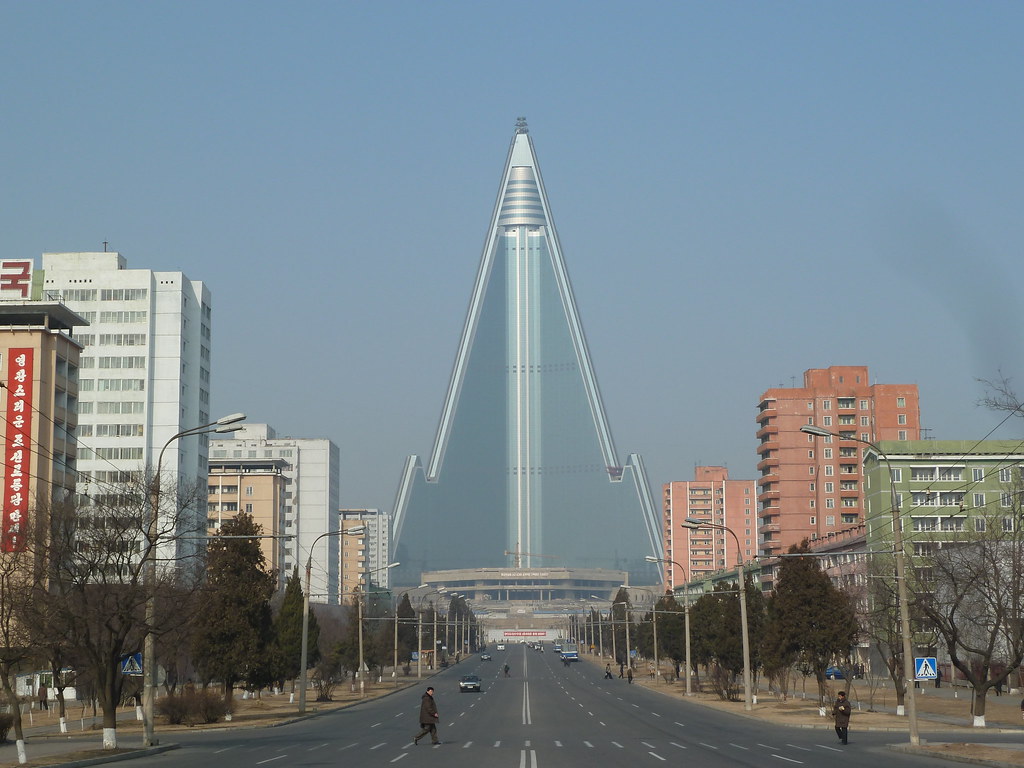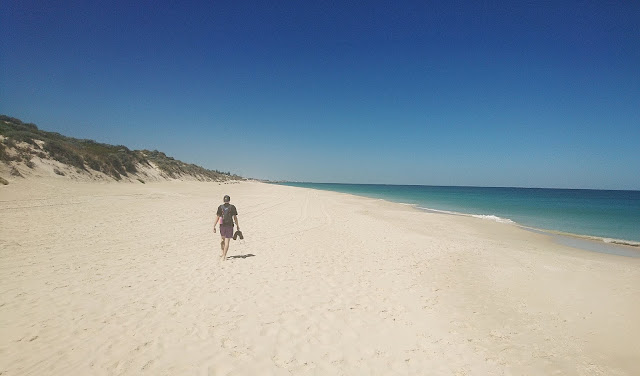Tourism in North Korea
 |
| Ryugyong Hotel - Pyongyang, North Korea by markpanama, on Flickr |
(DISCLAIMER: I am not an expert on this topic. To the best
of my knowledge this information is correct, but I cannot claim that there will
be no inaccuracies.)
North Korea:
1860-Today
Since the 1860's North Korean history can be defined by the
ruling of the Kim family. In 1894, Japan conquered Korea, long before it split into North and South. The Japanese weren’t exactly kind to their conquered nation,
suppressing their freedom of speech and forcing them to work for the Japanese
economy. Independence activist, Kim Hyong Jik, was arrested by the Japanese in 1917. Whilst in prison he heard of
revolutions taking place in Russia, and made the decision that Korea should
follow in Soviet footsteps towards a communist future.
In 1926, Kim Hyong Jik dies, and his 14 year old son, Kim Il
Sung, follows on his fathers path to become a large political influencer. Kim Il Sung
establishes the DIU (Down with Imperialism Union), in an effort to reclaim
Korea back from the Japanese. In 1929, Kim Il Sung begins to employ guerrilla
tactics in order to attack the Japanese. (Guerrilla warfare is where a
small group of individuals use military tactics such as ambushes, sabotage,
raids etc. to fight a larger and more traditional army). In 1939 WWII begins,
and Japan tightens its control over North Korea, forcing Korean men to fight
against the allies, and women were drafted as 'comfort women' (or sex slaves)
for the soldiers. For Japan, the war ends with their Kwangtung army being
defeated by the Soviet Union, followed imminently by the bombing of Nagasaki
and Hiroshima by the US. Consequently Japan surrenders Korea, and 1945 is remembered
within the country as 'the liberation of Korea'. During the war Kim Il Sung
gained notoriety within the Soviet Union as a strong leader, and so they
appointed him head of the country. After years of talks, in 1948 an official
divide was declared between North and South Korea. The North was backed by the
Soviet Union, where the South was backed by the US.
In 1950, Kim Il Sung convinced Joseph Stalin, that there was going to be an inevitable attack from South Korea, and so in order to defend themselves, they should attack first. (Although Korean literature does not report this, and claims that the US unnecessarily invaded the country). What then ensued was the Korean War. After a short battle with South Korea, the US joined to aid them, however after a year of fighting it was evident that the battle had reached a stalemate, and so a treaty resulting in no fighting was established between the north and the south, however an official end to the war has never been declared. Following the war, Kim Il Sung heavily instated the political ideology of 'Juche'. This is based around the concept of self-reliance, resulting in North Korea having no interaction with the outside world, with a large emphasis on self-defence, and has led towards the oppression of the North Korean people. By the 1970's Korea had cut practically all ties with China, resulting in a massive decline of the economy by the mid 80's. In 1991 the Soviet Union collapsed, removing Korea’s only external supply of income.
In 1950, Kim Il Sung convinced Joseph Stalin, that there was going to be an inevitable attack from South Korea, and so in order to defend themselves, they should attack first. (Although Korean literature does not report this, and claims that the US unnecessarily invaded the country). What then ensued was the Korean War. After a short battle with South Korea, the US joined to aid them, however after a year of fighting it was evident that the battle had reached a stalemate, and so a treaty resulting in no fighting was established between the north and the south, however an official end to the war has never been declared. Following the war, Kim Il Sung heavily instated the political ideology of 'Juche'. This is based around the concept of self-reliance, resulting in North Korea having no interaction with the outside world, with a large emphasis on self-defence, and has led towards the oppression of the North Korean people. By the 1970's Korea had cut practically all ties with China, resulting in a massive decline of the economy by the mid 80's. In 1991 the Soviet Union collapsed, removing Korea’s only external supply of income.
 |
| Kim Il Sung chats with farmers, south of Pyongyang (www.theatlantic.com) |
In 1994, Kim Il Sung dies, and is replaced by his son, Kim
Jong Il. Very quickly Kim Jong Il applies a new policy, which translates to
'military first'. As a consequence of the fall of the Soviet Union, the redistribution
of resources to the military, and a devastating flood, North Korea faced a horrific
famine. This famine caused ~ 3million deaths, children were abandoned, and there
were reports of cannibalism and diseases due to malnutrition. Despite their
policy of 'self-reliance' , North Korea were desperate, and accepted help from the
UN, and from South Korea via the ‘sunshine policy’, however this was retracted
in 2010 due to North Koreas testing of nuclear weapons.
In 2011, Kim Jong Il dies, and his son, Kim Jong Un comes
into power as the 3rd supreme leader of North Korea. Despite having a more
relaxed approach to the free market and trade than his predecessors he still
strongly promotes the North Korean military, and under his ruling there have
been three nuclear tests - one in 2013 and two in 2016. This brings us to Korea
today.
North Korea Today
Today North Korea remains nominally communist, and whilst it
still receives protection from China, it does not receive aid in the form of
material goods, and tensions between the countries are running high. Along with
the retraction of the sunshine agreement, and reluctance from the US to provide
aid whilst they are still growing their military, the threat of another famine
is always on the horizon. Nuclear ambitions still lie strong within the
country, prolonging tensions with the US and the rest of the world. Last year
North Korea began talks with the US to officially end the war with South Korea;
however these were cut short after more nuclear testing from the country.
 |
| Kim Jong Un greeting crowds in Pyongyang (Andy Borowitz - The New Yorker) |
In addition to no one entering the country via the DMZ, no
journalists or press are allowed in at all. As a result reports of the true
state of the country are limited, but here are just some of the human rights
atrocities that are allegedly taking place in North Korea today:
- Forced labour from as young as age 11
- Criticism of the government can result in execution or being sent to a ‘re-education’ camp
- Reports of executions due to religious practice (North Korea is an atheist country, following in Kim Il Sung's influence)
- Individuals cannot travel around the country – if they attempt to flee to China they will be sent back
- Major censorship of media
- Babies born with birth defects are rapidly put to death
- Individuals who escape to China and fall pregnant whilst in the country will be forced to abort their babies if they are sent back to North Korea
- Forced prostitution
- Imprisonment for disrespecting the leaders, e.g.: folding a newspaper with the leaders face on.
So.. Tourism?
Tourism in North Korea is increasing, with many thousands of people now visiting each year. These trips are extremely controlled, where you follow a strict tour and unless in your hotel room, you will have to be accompanied by two people at all times. As a consequence the image you receive of North Korea will be one that the government chooses to project to you, and not a true reflection of the state of the country.
 |
| North and South Korean gymnasts at 2016 Olympic games. (REUTERS) |
The question that this all boils down to is, where do you
want to spend your money? Should we boycott any tourism in the country as a
protest against the reported atrocities that are still taking place? Or should
we aim to fuel their tourism so they can grow and provide more for their
citizens, at the risk that they may pour the income into military, rather than
people.
Personally, I'm going to play the waiting game. Whilst I would
love to visit such a fascinating country, I feel not enough is known about what
goes on behind the scenes for me to make an informed decision about partaking
in their tourism. However a lot can change with time and my hope is that 30, or
40 years in the future, North Korea may be an open and safe place to live and
visit. And then I will be on the very first plane over to marvel at this mesmerizing
country. But until then, for me at least, it will remain largely a mystery.
Happy Travelling
Vicky
NOTES:
If you want to help those who have successfully defected from North Korea:
http://www.libertyinnorthkorea.org/
If you want to read up on a few topics here are some great places to begin:
https://www.state.gov/documents/organization/186491.pdf (A 'state of the country' document issued by
the US'
http://www.korea-dpr.com/ (North Korea's official website.
Lots of history all from Koreas stand point - very interesting reading)
A few popular youtubers talking about North Korea:
https://www.youtube.com/watch?v=L8z7u7Agdo8 (Emma Blackery
gives a sound summary of the last 100 years of North Korea)
https://www.youtube.com/watch?v=VmCpTzA6SKc (FunForLouis
goes on an actual tour of North Korea, this was a very controversial video last
year)
https://www.youtube.com/watch?v=Mh5LY4Mz15o (A brilliant
video on the history of Japan, gives a Japanese perspective to their
relationship with North Korea).


Comments
Post a Comment